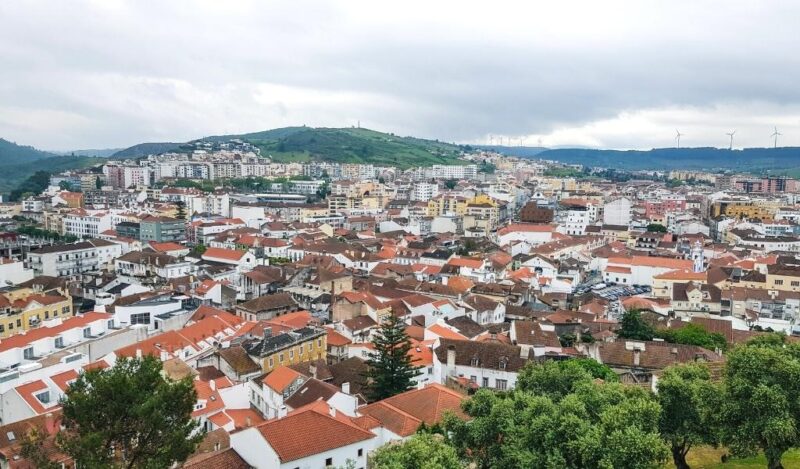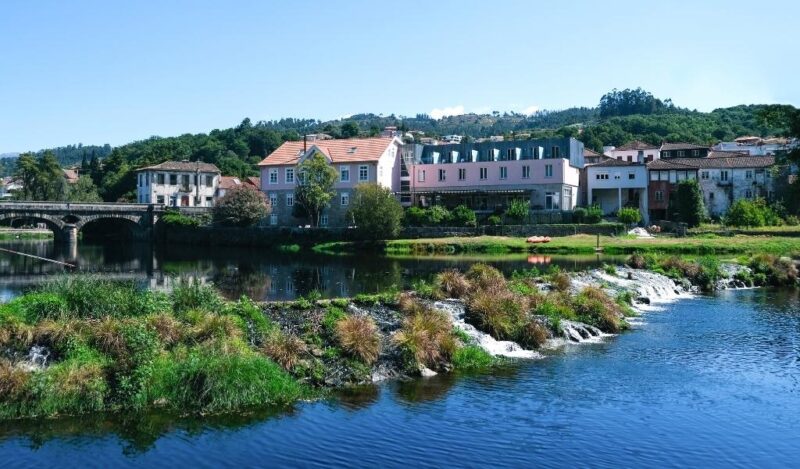Located in Arganil in the Coimbra district, the picturesque village of Piódão is one of the “12 Historical Villages of Portugal” (a program created by the Portuguese government in 1991, to restore and enhance a series of villages in the Beira Interior region, older than the country itself).
Piódão is also known as “The Nativity Scene Village” or “The Most Typical Village In Portugal”, because of its narrow, steep, and maze-like alleys, and its dozens of “dollhouses”, with schist walls, roofs covered with slabs, and doors (as well as windows) painted in blue!
So, do you want to know more about 1 Day In Piódão: The Perfect Piódão Itinerary? Keep reading!
This post may contain affiliate links, meaning I earn a small commission if you make a purchase, at no additional cost to you. Please read my disclosure & privacy policy for more information.
No time to read now? Pin it for later!


Brief History of Piódão
The small village of Piódão developed on a slope of the Serra do Açor (one of the highest mountain ranges in mainland Portugal) during the Middle Ages. At that time, it was called Casas Piódam and its inhabitants were mostly shepherds and farmers.
Although there are no traces left, historians believe that a Cistercian monastery dating from the 13th century once existed here. And with the presence of a monument of this religious order in this place, it’s possible to find a link to the first invocation of Saint Mary of the Parish Church of Piódão – built in the 18th-19th century.

Unlike the other Historical Villages of Portugal, Piódão was not decisive in the Christian Reconquista, nor did it have any important defensive role in the country’s history. In fact, its inhospitable location led to the village remaining unknown to the Portuguese for several centuries!
However, there’s a curious episode in the history of Piódão that mixes with that of Portugal: legend has it that Diogo Lopes Pacheco (one of the advisers of King Afonso IV who were hired by the king himself to assassinate Inês de Castro) took refuge in one of these houses, after committing the crime!
Visiting Piódão
Piódão is, without a shadow of a doubt, the most difficult historical village in Portugal to reach. Public transportation is practically non-existent – unless you book an excursion at a travel agency – and the roads are quite dangerous. In addition, the nearest historical village is Linhares da Beira, more than 70 km away!
Honestly, some of the 12 Historical Villages of Portugal can be visited in one morning or afternoon, as is the case of Castelo Mendo, Idanha-a-Velha, Linhares da Beira, Marialva, Piódão, or Sortelha. As for the others, it depends on the number of monuments you want to include in your itinerary.
Since Almeida, Belmonte, Castelo Novo, Castelo Rodrigo, and Monsanto are towns, it’s likely that you’ll need a day (or two) to explore them from one end to the other. And the same happens with Trancoso, which is a city. By the way, here’s the list of the 12 Historical Villages of Portugal:
- Almeida, in the Guarda district
- Belmonte, in the Castelo Branco district
- Castelo Mendo, in the Guarda district
- Castelo Novo, in the Castelo Branco district
- Castelo Rodrigo, in the Guarda district
- Idanha-a-Velha, in the Castelo Branco district
- Linhares da Beira (or simply Linhares), in the Guarda district
- Marialva, in the Guarda district
- Monsanto, in the Castelo Branco district
- Piódão, in the Coimbra district
- Sortelha, in the Guarda district
- Trancoso, in the Guarda district
Piódão Itinerary
Bust of Canon Manuel Fernandes Nogueira
Manuel Fernandes Nogueira was born in 1861 in Loriga, a small village in the municipality of Seia (in the Guarda district). After being ordained a priest in 1884, he arrived in Piódão the following year to serve as parish priest of the historical village.
Canon Manuel Fernandes Nogueira remained in Piódão until 1907 and was a great supporter of the parish. For example, in 1886, he founded a college that prepared young men to enter the ecclesiastical career at the Seminary.
The school was eventually destroyed in 1906, to make way for the current Cónego Manuel Fernandes Nogueira Square, the gateway to the village. And his bust is located exactly in the center of this square.

Parish Church of Piódão
As I mentioned in the introduction, the Parish Church of Piódão was erected between the 18th and 19th centuries – more precisely in the second half of the 18th century, with deep reforms at the end of the following century (carried out by Canon Manuel Fernandes Nogueira).


Dedicated to Our Lady of the Conception, the Catholic temple has a façade with four cylindrical buttresses, crowned with conical towers – unusual elements for the time, especially in religious buildings! Inside, there’s a beautiful altarpiece in gilded woodwork with images of various saints.
Saint Peter’s Chapel

To get to Saint Peter Chapel, first, you have to “get lost” in the cluster of schist houses that form the heart of the village of Piódão.
Now, as you may have noticed from the photograph, this monument is quite small and modest. It was built between the 17th and 18th centuries but underwent some architectural reforms in the 20th century.
Its exterior matches the other temples in Piódão (such as the Parish Church or the Almas Chapel), as it features whitewashed walls with accents in shades of blue and a roof covered with Portuguese tile. Inside, there’s an image of Saint Peter, which dates from the 16th century and gives the chapel its name.
Algares Fountain
The Algares Fountain is a monument that not all tourists who visit Piódão find, due to the lack of signs in this complex labyrinth of alleys. By the way, I confess that I only saw it because I was passing by!
This fountain was built in 1968 and is housed in a small niche with a pointed arch. In the center, there’s an image of Our Lady, in a kind of “improvised altar”.
But the most fascinating aspect of the Algares Fountain is that it was carved into a schist wall, under the terrace of a private house. So, it’s no surprise that it goes unnoticed by the less curious eyes!

Almas Chapel

Piódão may be a tiny and very compact village, but it’s true that it has many temples. Well, the Almas Chapel (or Chapel of Souls) is just one more of them!
Located on the edge of the village, the Almas Chapel is about 250 meters from the cemetery. And do you know why? Because it served as a mortuary chapel for the population of Piódão (and other neighboring villages from the municipality of Arganil), for several decades!
Dating back to the 18th century, the Almas Chapel was modified in the 20th century and has a wooden altarpiece with a painting of the so-called “Souls in Purgatory”.
River Beach
Piódão’s River Beach (sometimes called the Piódão’s River Pool) is the wonder of tourists who visit this historical village in the hot summer months. It’s a river area recognized by the Blue Flag Program since 2016 and whose bathing season usually takes place between early July and late August.

Here, you’ll find a pool of clear (and cold) water, coming directly from the springs that cool Piódão and flow into a stream with the same name. In addition to being a river beach guarded by lifeguards, it also has restrooms, an information desk, a first-aid post, and a kiosk bar.
Map of the Piódão Itinerary
Share this blog post on your social media!
More Posts about Portugal
4 Best Monasteries In Portugal (That You Should Visit This Year)
5 Best Palaces In Sintra (That You Should Visit This Year)
1 Day In Penafiel: The Perfect Penafiel Itinerary
More Posts about Travel Itineraries
1 Day In Penafiel: The Perfect Penafiel Itinerary
1 Day In Torres Vedras: The Perfect Torres Vedras Itinerary
2 Days In Arcos De Valdevez: The Perfect Arcos De Valdevez Itinerary
What Photography Gear Do I Use?
- Camera Body: Fujifilm X-T4 Mirrorless
- Camera Lens: Fujinon XF 18-55 mm F2.8-4 R LM OIS
- Tripod: Manfrotto Compact Action
- Small Tripod: Manfrotto PIXI Mini
- Smartphone Adaptor: Manfrotto PIXI Clamp
- Memory Card: SanDisk 128GB Extreme PRO SDXC





